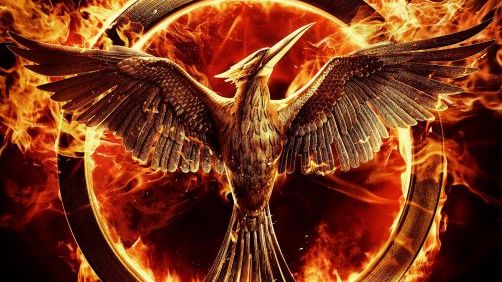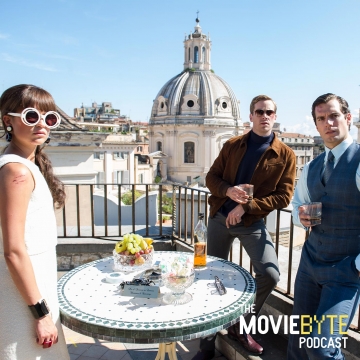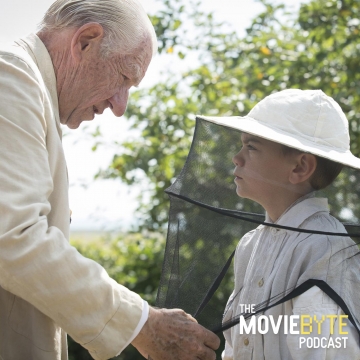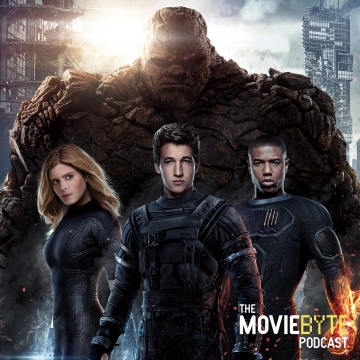
This is the point at which I realize I never got around to writing my written review of The Hunger Games: Catching Fire and realize that I have not seen it recently enough to do so. That’s sort of frustrating. Make no mistake, it is always my intention to write a review of every film I see. I am not always able to get around to doing it.
Luckily, I did write a review of the first Hunger Games film. It was very early in the days of MovieByte when these films first began making their appearance. Joe and I also talked about it on episode 7 of The MovieByte Podcast. The first installment was directed by Gary Ross. You can read my review here and see that I gave it four out of five stars. My general thoughts were and are that Gary Ross brought several good things to the table. The casting was top notch — Jennifer Lawrence as Katniss Everdeen continues to be one of the best casting choices I’ve seen in recent years and Stanley Tucci as Ceaser Flickerman is absolutely delightful — the sense of story was great, and the pacing was very well done. Where Gary Ross’ shortcomings are most apparent is in the camera work, the visual sensibilities, and the need to use super closeups, all handheld, and general claustrophobic and wretch inducing jitters.
Catching Fire maintained Ross’ cast but brought in a new director who has much more traditional sensibilities. Where Gary Ross valued novelty and transient modern filmmaking techniques, our new director, Francis Lawrence, believed that tried and true techniques in the making of the second film would be far more effective. It is no surprise to you, my reader, that I despise most new and novel filmmaking. There are, of course, exceptions, but for the most part, as far as filmmaking technique and story telling are concerned, there is a reason the tried and true ways are tried and true. There is good story telling and there is bad storytelling.
Lawrence’s camera work was anything but claustrophobic and jittery in Catching Fire. As any good filmmaker knows, hand held camera work has it’s place, but it is not great to tell an entire story with the technique. Instead, Catching Fire’s cinematography is slow and steady, close-ups are used when appropriate instead of all the time, and the story is told with a much better sense of eb and flow. While the pacing of The Hunger Games was decent, the pacing of Catching Fire was far superior. In short, Francis Lawrence’s film made me almost want to retroactively downgrade my rating of the original.
I talked about the film with Chad and Fizz on episode 70 of The MovieByte Podcast.
So what might Francis Lawrence bring to the table in this next installment?
Katniss is… troubled

To say that Katniss is troubled might, in fact, be the biggest understatement of the year. She’s utterly broken by the games and Jennifer Lawrence’s ability to portray Katniss in this state is nothing short of fantastic. And it’s understandable that she’s not doing so well. Try putting yourself in her position. It was bad enough that she fought in the first hunger games. She was put in an arena with many other kids of varying ages all trying to kill each other and become the victor. She was forced to kill to survive. She watched as alliances she made were killed in cold blood. In the end, because she couldn’t bring herself to kill the only other survivor of the games, she refused to claim victory and chose instead to defy the capitol and two victors emerged. That was all bad enough. It was traumatic and anyone could see that the effects of that would ruin her for the rest of her life.
But her defiance against the capitol in refusing to play the hunger games as they were intended brought the wrath of President Snow down upon her. He came up with a scheme to force her into he games again. And the results were even more traumatic. In the end she is rescued by the ever before allusive district 13. But the experience has left her traumatized and broken.
It should be no surprise to us that Jennifer Lawrence can portray this in a most believable fashion, and one which we can identify with. She was nominated for two Academy awards and won the first one. But even so, she manages to bring new depth and dimension to the character that I’m not sure we even saw in the book.
Improving on the book
I’ve made my mixed feelings on the books abundantly clear, actually, but I’ll repeat it for the record. The first book was great, the second book was good, the third book was “meh”. In short, there’s a sort of stair-step spiral — a very identifiable arc which leads downward. I think Suzanne Collins had a great start to a story and didn’t know where to take it and failed to infuse the story and characters with more nuance.
Thus far, each film has, in my estimation, been an improvement on the book. This is in opposition to my feelings on something like, say, the Harry Potter series. Those films were all over the map in terms of quality and story telling. And as much as I liked some of them (and hated others of the films), none of them lived up to any of J.K. Rowling’s fantastic books.
Mockingjay, the book, really felt as if Collins had no clear vision and plan for bringing the series to a close. The characters felt one dimensional and under developed. And the end of the book felt out of place and unsatisfactory.
We have yet to see if the films can fix that final fatal flaw I mentioned, but the other flaws have been quite improved upon. I don’t often feel that a film series based on a book can improve upon the source material, but there are exceptions and I think these films fall in that exception category.
Performance Highlights

Philip Seymour Hoffman
As one might expect, the loss of Philip Seymour Hoffman this year is still a stinging wound that this film manages to re-open. His performance in the previous film was good, his performance in Mockingjay, Part 1 is amazing. Sure, it’s a supporting role, but it’s a necessary one, and one he put the full weight of his impressive talent behind and turned into something far better than we might even imagine.
Hoffman’s talent lies in understatement, and that’s precisely what he gives us here. There are several times during tense situations when director Francis Lawrence cuts to show us how Hoffman’s Plutarch Heavensbee is handling and responding to the situation, and the understated but present fear in his eyes, in his look, in the slight shake of his hand, communicates everything we need to know about the present situation.
Julianne Moore
I’m not Julianne Moore‘s biggest fan. There’s something about her that gets on my nerves and slightly creeps me out. Nevertheless I must grudgingly admit that I think President Coin was the role she was born to play. Her creepiness works for the character — perhaps because I know where she is going and I know the foreshadowing of what is to come. Her performance gives the character that creepy flare that we know is there. Her own ambitions are far more important than anything else and that shows pretty clearly.
Woody Harrelson
We’ve been watching Woody Harrelson‘s Haymitch Abernathy grow and change as a character since the first installment. He yet again impresses us as his growing love and affection for Katniss deepens even more. He’s almost but not quite a father figure that she needs. He understands her and in many ways, she him. His role is almost tender — which is a far cry from the Haymitch we saw in the first two films. But as always, character journeys are quite welcome by me, and this is a good one. He’s a good-for-nothing drunk who’s been hurt too many times by the tributes to bother to care anymore for fear of breaking his heart yet again. Imagine if it was your job to train and mentor a tribute every year, who would then go to the arena and die while you watched it on screen? Rinse and repeat every year for, what? 30 years? It’s easy to understand how he became the jaded man that he was in in the first film. But despite that, his fondness for Katniss grows into something else and changes his character in measurable ways that we can watch in the films. The result is fairly satisfying and one I’m hoping to get more of in the next film.
Donald Sutherland
President Snow as portrayed by Donald Sutherland may not quite be up to Voldemort levels of pure, unadulterated evil, but in his own way, he does come close. His giddy, evil glee in his final scene in part one is chilling. He’s cool and calculated and menacing. His calculation gives great weight to the fact that the team extracting Peeta Melark from the capital is not fired upon when leaving. We know something is going on, he’s scheming and planing something, but we know not what just yet. It’s quite effective. Remind me never to cross Donald Sutherland.
Part 1
Splitting the final installment in a series into two parts has become all the rage these days, but this may be the most part one-iest part one of any part one I have ever seen. The film literally did not end. The story did not come in for a landing. It just got to the mid-point (presumably) and ended. There were no end credits, 1 there was not a traditional film ending. Two part installments in film series such as Harry Potter and the Deathly Hallows, Part 1 did at least have an ending. The film came in for a landing and there were end credits. Because despite the fact that there are two parts to the story, it is a self contained film that will be viewed by itself.
Well, Francis Lawrence seems to feel that the two parts should ultimately be viewed as on thing. Like a two sided disc. It doesn’t matter that we won’t be able to flip the disc over for a year, it’s one film split into two parts — quite literally. There were no end credits, there was no feeling that the story was coming in for a landing — a rest and wait for the next installment. The screen cut to black, we were presented with the Mockingjay logo, and then text that dedicated the film in loving memory to Philip Seymour Hoffman (which was quite touching by the way and I’m not complaining about that). So that was weird.
But that strangeness aside, the film felt like an ever building and every escalating tension that never had a release. Ultimately, when the film is out on home video and we can view it all in one sitting, we might be grateful for the way this film is made in that way, but for now it remains a little frustrating. I won’t complain too much about it and I certainly won’t lower my rating because of this issue, but it is very strange. And I’ve even struggled with how to give a star rating for half a film. Maybe I should wait until next year and give the film in its entirety a star rating. But this film was released on it’s own and should be rated as such.
I do actually find that I quite liked the pacing of the film. Splitting this final chapter up into two parts has advantages in that way and I almost felt like I wished the previous film had been split in two if we could get pacing like this. There was no sense of rush, no unnecessary urgency. I like the thoughtfulness of the film and the sense of time and foreboding.
Love Triangle
As ever, I feel that Josh Hutcherson doesn’t quite belong in this film and was miscast. As such we now have to live with that. While fortunately he isn’t on the screen much, I have a sense of dread every time I see him on the screen. And I know he’s going to have to be on screen a bit more in part two. This is actually a problem that goes back to the book as well. Katniss eventually realizes that she has fallen in love with Peeta even though in many ways she should love Gale Hawthorne (unfortunately the book resolves the tension by turning Gale into a first class jerk). It’s not that Peeta never did anything to win her love, it’s just that it’s written poorly and acted poorly in the films. We don’t see much of a reason for Katniss to love him except they were thrown into this situation together. His redeeming quality was his compassion which has been stripped of him in this part of the story.
Gale of course, is a far better match for Katniss in many ways, except he’s too needy (the only way I can get your attention is when I’m hurting, Katniss — sick). Ultimately, these two characters exist only to create a triangle of frustration both for Katniss and for us. Frankly I’m sick of the love triangle stuff. Find something else to write and tell stories about.
Conclusion
Given the frustration with the characters of Peeta and Gale, it’s hard for me to rate this film quite as highly as the previous film. It’s also hard based solely on the fact that this is but the first installment in a two part film. But don’t let me put you off from seeing the film. It’ is a good one and worthy of your attention. Don’t let the critics fool you. They are such a fickle lot. The Rotten Tomatoes Critic Consensus says that the film comes up short on the action. As if the critics think action is the end all and be all — what a joke. I found the film to be compelling, it did in fact have some action which I deemed to be enough for me, I liked the pacing and much of the acting, the story is improved upon from the book, and I quite enjoyed watching the film in the theater.
My remaining hope is that Francis Lawrence and co can drastically improve upon the ending. I look forward to the final installment in this series with slight trepidation because I know the book’s ending is not quite what I might have hoped for. But as much improvement as the films have been making on the books, I have hope.
I did wonder if something didn’t go wrong at my theater with the projection, and Michael Minkoff’s comment below now has me really wondering. I got the end logo and the dedication to Hoffman, and then a black screen. But the lights never came back up. I waited for about 2 minutes of black screen and no music before I finally concluded that I wasn’t going to get end credits. I’ll have the chance to ask Fizz on the podcast later this week. ↩


